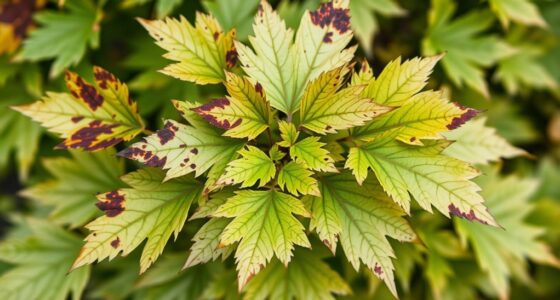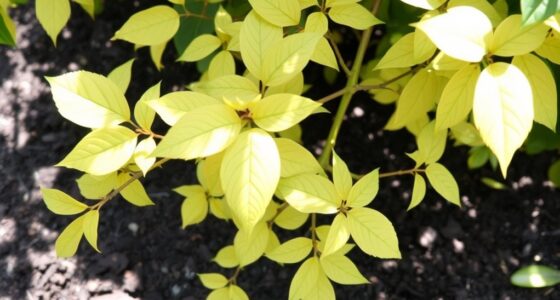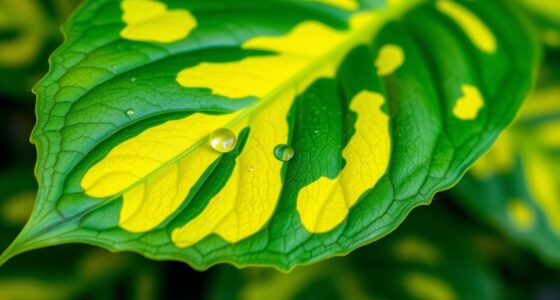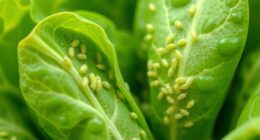If your fiddle leaf fig’s leaves are crispy and browning, low humidity and poor water quality are likely causes. To fix this, increase humidity with a humidifier, misting, or pebble trays, and keep a hygrometer nearby to monitor levels. Use filtered or distilled water to prevent mineral buildup and promote healthy leaf growth. For more detailed tips on restoring your plant’s health and preventing further damage, explore the solutions below.
Key Takeaways
- Increase humidity using humidifiers, misting, or pebble trays to prevent leaf crispiness caused by dry air.
- Use filtered or distilled water to reduce mineral buildup and chemical stress on leaves.
- Regularly monitor humidity levels with a hygrometer, maintaining 40-60% for optimal leaf health.
- Improve water quality by flushing soil periodically and avoiding unfiltered tap water with high mineral content.
- Prune damaged leaves, ensure proper airflow, and maintain stable environmental conditions to support healthy, vibrant foliage.
Recognizing the Signs of Low Humidity in Your Fiddle Leaf Fig

If your fiddle leaf fig’s leaves are turning crispy and brown at the edges, it’s a strong sign that the humidity levels are too low. Low humidity can cause dehydration, leading to poor soil aeration, which hampers root health and nutrient uptake. When roots struggle to access essential nutrients due to compacted or poorly aerated soil, your plant can develop deficiencies that worsen leaf damage. Additionally, dry air makes leaves lose moisture faster, leaving them brittle and prone to browning. To confirm low humidity, check the environment and observe leaf condition. Improving humidity, along with ensuring proper soil aeration, helps your fiddle leaf fig absorb nutrients effectively and keeps its leaves healthy and vibrant. Proper humidity levels also support the plant’s color accuracy and overall growth, preventing further stress and damage. Maintaining adequate humidity is especially important in indoor environments, where air tends to be drier.
How Poor Water Quality Affects Leaf Health and Appearance

Poor water quality can considerably impact the health and appearance of your fiddle leaf fig’s leaves. When you use water with high mineral content or contaminants, it can disrupt soil nutrients, leading to nutrient imbalances that cause leaf browning, crispiness, or spots. These deficiencies weaken the plant’s overall health and make it more vulnerable to pest infestations, which further damage the leaves. Additionally, poor-quality water may leave mineral deposits on the leaf surface, creating a crusty appearance and reducing photosynthesis. Over time, this stress can make the leaves look dull, crispy, and less vibrant. To prevent these issues, consider using filtered or distilled water, ensuring your plant receives clean water that supports healthy soil nutrients and keeps pests at bay.
The Role of Humidity in Fiddle Leaf Fig Vitality

You need to keep your fiddle leaf fig in an environment with proper humidity levels to thrive. If the air is too dry, you’ll notice crispy edges and browning leaves. Increasing indoor moisture through simple methods can help maintain your plant’s health and prevent damage. Implementing humidity control techniques can significantly improve your plant’s vitality, especially when combined with ensuring adequate water quality for optimal growth. Proper watering practices, including using quality water, can also make a substantial difference in preventing leaf crispiness and supporting overall plant health.
Optimal Humidity Levels
Maintaining the right humidity levels is essential for the health of your fiddle leaf fig, as it directly influences leaf significance and overall growth. Optimal humidity, around 40-60%, helps your plant absorb essential nutrients, supporting robust plant nutrition. When humidity is too low, leaves become crispy and more susceptible to pests, making pest management harder. Proper humidity creates a stable environment that reduces stress on your plant, promoting healthy leaf development and preventing issues like leaf browning. Consistently maintaining these levels ensures your fiddle leaf fig stays vibrant and resilient. Use a humidifier or pebble tray if needed, especially in dry indoor spaces. Additionally, understanding the role of humidity levels in plant health can guide better care practices. Keeping humidity in check ultimately enhances your plant’s overall vitality, making it easier to care for and enjoy its lush foliage. Regular monitoring with a hygrometer can help you maintain these ideal conditions and prevent dryness or overwatering issues. Ensuring proper plant hydration is also vital for preventing leaf crispiness and maintaining overall health.
Signs of Low Humidity
When humidity levels drop below the ideal range, your fiddle leaf fig will start showing clear signs of stress. You may notice the leaves curling at the edges, a sign that the plant is losing moisture faster than it can absorb it. Additionally, leaf discoloration can occur, with the foliage turning yellow or brown, especially along the margins. These symptoms indicate the plant is struggling to maintain proper hydration. Low humidity causes the leaf cells to lose water, leading to dehydration and deterioration of leaf tissue. If you observe curling leaves or uneven discoloration, it’s a strong sign that the air is too dry for your fiddle leaf fig’s health. Monitoring soil moisture and increasing humidity with a humidifier can help address these symptoms promptly, preventing more severe damage and keeping your plant thriving. Using a humidifier with adjustable settings can help maintain consistent humidity levels and prevent future issues. Ensuring proper water quality by using filtered or distilled water can also reduce the risk of leaf crispy edges caused by mineral buildup.
Increasing Indoor Moisture
To keep your fiddle leaf fig healthy and vibrant, increasing indoor humidity is essential, especially during dry seasons or in low-humidity environments. Use humidity sensors to monitor moisture levels accurately, ensuring you don’t over- or under-humidify. Misting techniques can help boost humidity around your plant; lightly spray water onto the leaves daily, but avoid overdoing it to prevent fungal issues. Placing a tray of water with pebbles beneath your plant can also create a humid microclimate as the water evaporates. Maintain consistent humidity levels, ideally between 40-60%, to prevent leaf crispy and stress. Regularly check the humidity sensors and adjust misting frequency accordingly, creating an ideal environment that supports your fiddle leaf fig’s vitality and lush, healthy leaves. Incorporating natural lighting can further improve your plant’s overall health and growth conditions.
Water Quality Factors That Contribute to Crispy Leaves

Poor water quality can lead to crispy, damaged fiddle leaf fig leaves because minerals and contaminants in the water can stress the plant’s roots. When your water isn’t properly treated, minerals like chlorine or excess salts build up in the soil, causing dehydration and leaf crispiness. Ensuring proper water treatment—such as letting tap water sit or using filtered water—can reduce harmful substances. Additionally, maintaining the right pH balance is vital; water that’s too acidic or alkaline can hinder nutrient absorption, weakening the plant. Regularly testing and adjusting your water’s pH helps keep your fiddle leaf fig healthy. Addressing water quality factors like treatment and pH is crucial for plant health, as poor water quality can significantly impact its overall vitality. Using proper water management techniques can also prevent mineral buildup and support overall plant wellness. Being aware of water testing methods can help ensure your water quality remains optimal for your plant’s needs.
Practical Steps to Increase Humidity for Your Plant

You can increase humidity by grouping your plants together so they create a microenvironment with higher moisture levels. Using a humidifier nearby also helps maintain consistent humidity, especially in dry indoor spaces. Combining these methods ensures your fiddle leaf fig stays healthy and its leaves stay lush.
Group Plants Together
Grouping your plants together is one of the simplest and most effective ways to boost humidity around them. When your plants are close, they create a microenvironment that retains moisture, helping prevent the air from becoming too dry. This also promotes better soil aeration, as plants transpire more collectively, increasing humidity naturally. Additionally, grouping plants makes pest prevention easier; if pests appear, you can address them quickly and prevent spreading. Keep in mind that crowded plants need proper airflow to avoid mold or disease, so space them just enough to allow circulation. This method not only raises humidity but also supports healthy growth by creating a balanced environment that benefits your fiddle leaf fig and other plants. Proper air circulation is essential to prevent mold and ensure your plants stay healthy while enjoying the benefits of increased humidity. Maintaining appropriate airflow helps avoid issues like mold and disease, which can be exacerbated by overly crowded conditions.
Use Humidifiers Effectively
Using humidifiers effectively can considerably boost moisture levels around your fiddle leaf fig, especially when natural methods like grouping aren’t enough. Place the humidifier near your plant but avoid direct contact with leaves. Regularly check soil aeration to prevent root rot, as higher humidity can trap excess moisture. Incorporate plant pruning to promote healthy growth and better airflow, reducing the risk of crispy leaves. Keep the humidifier clean to prevent mold buildup. Use a hygrometer to monitor humidity levels, aiming for 40-60%. Consider a diffuser or misting, but avoid overdoing it. Adjust the humidifier based on seasonal changes, ensuring consistent moisture without over-saturating the environment. Proper use helps restore your plant’s vibrant, healthy foliage. Additionally, understanding industry trends can help you stay informed about the best practices for plant care and humidity management. Maintaining optimal humidity levels is crucial for preventing crispy leaves and ensuring your fiddle leaf fig thrives. To optimize humidity control, it’s helpful to learn about humidifier settings and their impact on indoor plant health.
Improving Water Quality to Promote Leaf Wellness

Since tap water often contains chlorine, fluoride, and other chemicals that can stress fiddle leaf fig leaves, improving water quality is essential for their health. Use filtered or distilled water to prevent chemical buildup that can cause leaf crisping. Poor water quality can also affect soil nutrients, making it harder for your plant to absorb essential minerals. Regularly check for signs of pest issues, as stressed plants are more vulnerable. Proper watering with clean water promotes healthy root systems, supporting nutrient uptake and overall leaf well-being. Keep a consistent watering schedule to avoid over- or underwatering, and consider periodically flushing the soil to remove mineral deposits. These steps help maintain ideal water conditions, leading to lush, resilient leaves.
Additional Tips for Preventing Leaf Browning and Crispening

To prevent leaf browning and crispening, it’s important to monitor environmental conditions and adjust accordingly. Keep humidity levels steady, avoid drafts, and ensure proper watering. Regular pruning techniques help improve airflow and remove damaged leaves, reducing stress on the plant. Also, inspect your plant regularly for pests, as infestations can cause leaf damage and browning. Use gentle pest prevention methods like neem oil or insecticidal soap to keep pests at bay without harming your fiddle leaf fig.
Maintain steady humidity, prune damaged leaves, and watch for pests to keep your plant healthy.
- Maintain consistent humidity and temperature
- Prune dead or damaged leaves promptly
- Use clean pruning tools to prevent disease
- Regularly check for pests and treat early
- Avoid sudden environmental changes
Frequently Asked Questions
Can Adjusting Humidity Alone Restore My Fiddle Leaf Fig’s Leaf Health?
Adjusting humidity management can considerably improve your fiddle leaf fig’s leaf hydration, but it might not fully restore leaf health if other issues exist. High humidity helps prevent crispy, dry leaves, but ensure you’re also providing proper watering and good water quality. Combining humidity control with appropriate watering practices will give your plant the best chance to recover and maintain healthy, vibrant leaves.
What Specific Water Contaminants Cause Leaf Crispiness?
Imagine your fiddle leaf fig’s leaves as delicate parchment, crisping under unseen threats. Contaminants like imbalanced water pH and mineral buildup act like tiny ships clogging its roots’ pathways. These impurities prevent the plant from absorbing essential nutrients, causing leaf edges to dry out and curl. To protect your plant, use filtered water, check pH levels, and flush out mineral deposits—restoring the health of your leafy companion.
How Often Should I Mist or Humidify My Plant?
You should mist or humidify your fiddle leaf fig daily, especially if you notice leaf curl or crispiness. A consistent watering schedule helps maintain proper humidity, preventing dryness that causes leaf damage. If your environment is dry, increase misting or use a humidifier. Keep the air moist around your plant to support healthy growth and prevent leaf issues, ensuring your fiddle leaf fig stays vibrant and strong.
Are There Natural Methods to Improve Water Quality for My Plant?
You can improve your plant’s water quality naturally by using natural water filtration methods like installing a charcoal filter or letting tap water sit overnight to reduce chemicals. Additionally, adding soil amendments such as compost or organic matter enhances soil health and helps filter impurities over time. These approaches support healthier roots and prevent crispy leaf edges, ensuring your fiddle leaf fig thrives with better water quality.
How Do Temperature Fluctuations Impact Leaf Crispiness?
Temperature fluctuations cause your fiddle leaf fig to experience temperature stress, which can lead to leaf dehydration and crispiness. When temperatures shift suddenly, your plant struggles to regulate moisture, resulting in dry, crispy leaves. To prevent this, keep your plant in a stable environment, avoid drafts, and maintain consistent temperatures. This helps reduce stress and keeps your leaves healthy and vibrant, avoiding that crispy, dehydrated look.
Conclusion
By paying attention to your fiddle leaf fig’s environment, you can prevent crispy leaves and keep it thriving. Increase humidity with simple tricks like misting or a humidifier, and use clean, filtered water to boost leaf health. Remember, a little care goes a long way—think of it as tending your garden with patience and love, like a gentle gardener from days of yore. Keep these tips in mind, and your plant will flourish, lush and vibrant.









